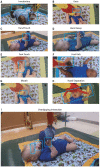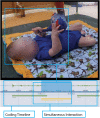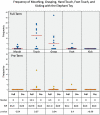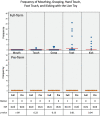Quantifying interaction with robotic toys in pre-term and full-term infants
- PMID: 37928351
- PMCID: PMC10622661
- DOI: 10.3389/fped.2023.1153841
Quantifying interaction with robotic toys in pre-term and full-term infants
Abstract
Infants born pre-term are at an increased risk for developmental, behavioral, and motor delay and subsequent disability. When these problems are detected early, clinical intervention can be effective at improving functional outcomes. Current methods of early clinical assessment are resource intensive, require extensive training, and do not always capture infants' behavior in natural play environments. We developed the Play and Neuro Development Assessment (PANDA) Gym, an affordable, mechatronic, sensor-based play environment that can be used outside clinical settings to capture infant visual and motor behavior. Using a set of classification codes developed from the literature, we analyzed videos from 24 pre-term and full-term infants as they played with each of three robotic toys designed to elicit different types of interactions-a lion, an orangutan, and an elephant. We manually coded for frequency and duration of toy interactions such as kicking, grasping, touching, and gazing. Pre-term infants gazed at the toys with similar frequency as full-term infants, but infants born full-term physically engaged more frequently and for longer durations with the robotic toys than infants born pre-term. While we showed we could detect differences between full-term and pre-term infants, further work is needed to determine whether differences seen were primarily due to age, developmental delays, or a combination.
Keywords: infant development; movement; neurodevelopment; neurorehabilitation; preterm birth; rehabilitation robotics; toy; vision.
© 2023 Kather, Shofer, Park, Bogen, Pierce, Kording, Nilan, Zhang, Prosser and Johnson.
Conflict of interest statement
The authors declare that the research was conducted in the absence of any commercial or financial relationships that could be construed as a potential conflict of interest.
Figures










References
Grants and funding
LinkOut - more resources
Full Text Sources
Medical

